Joel Ellis Dolls came out of Springfield, Vermont in the latter half of the 1800s beginning with his patent in 1873. Springfield had a community filled with inventors, many of whom worked together in different capacities and partnerships.
Joel Ellis’s Work
Making Farm Baskets
Joel Ellis dolls have a background that goes back to basket making. According to the “History of the town of Springfield, Vermont” Joel A. H. Ellis formed a partnership with D. M. Smith, Hamlin Whitmore, H. H. Mason, and Albert Brown in 1856 to engage in the manufacture of a patent farm basket in the brick shop which then stood just above a location known as the lower bridge or the Williams factory. J. A. H. Ellis patented the baskets in 1857 (US 0016953 A and US 0016970 A).
The Cab Shop
When the did not succeed, they ventured into manufacturing children’s cabs invented by Ellis, known as the cab shop business at the time. The new venture proved costly and Ellis’ partners decided to move on.
From there Ellis invented and sold some of the first toy carts ever on the market followed by doll carriages.
Ellis, Britton, & Eaton
About that time in 1858 (1859) Ellis formed a partnership known as Ellis, Britton, & Eaton with R. G. Britton and Ellis M. Eaton with a capital less than $1000. They rented the machinery and tools of the old firm, but within one year they succeeded well enough to buy the tools, machinery, and stock and decided to lease the building for the next five years. They even added more buildings. In 1863 the company bought the peg shop property from George Kimball. Adding water wheels, they also bought water privileges from a David Brown. Albert Brown also entered into this partnership for the manufacturing of children’s carriages.
Vermont Novelty Works
This company later became known as the Vermont Novelty Works. Legislation passed for the company to be incorporated in 1861 but Vermont has on record that it became a charter in 1861 and was incorporated in 1867.
By 1869 they had added to their sells such things violin and guitar cases, the first sold in the United States. During that time the business was valued at over $100,000 per year and paid taxes on goods they sold up to $22,500! They lost around $49,000 worth of assets during the flood that year loosing the factory, machinery and the stock.
Vienna Exhibition Connects to Joel Ellis Dolls
In 1873 newspapers announced that the Vermont Novelty Works presented one of its carriage to exhibition in Vienna.
The Novelty Works advertised the manufacturing of toy baby carriages in 1883 when Andrews Nathaniel served as secretary for the company. Ellis Easton still worked for the firm that year.
Losses from Flood and Fire
The year following the flooding of the Black River in 1869 they rebuilt the factory and formed the Vermont Novelty Works. A flood in 1863 had caused them dammage only six years earlier. One building added in 1870 had three stories and measured 40X70. The flood carried out or pushed through the dam built by the Vermont Novelty Works. William A. A. Heyer of Boston joined them as president. Joel Ellis served as treasurer and Albert Brown as secretary.
They suffered another loss about eight years later due to fire on June 25 of 1877 losing their shops. The loss from the fire totaled $7,000.
More Joel Ellis Inventions
In the meantime Joel Ellis busily registered other patents for inventions for such things as a device for stuffing-boxes for engines, a vapor-generator, and compound liquids for use in vapor-engines.
Springfield 1890 Advertisement
A listing in the Vermont Yearbook of 1890 the Vermont Novelty Works advertised carriages and sleighs. The yearbook ran a half page advertisement for them where they claimed to manufacture children’s carriages, toy wagons and carts, dexter rockers, boys express and goat wagons, toy cradles, girls’ sleighs, toy perambulators, toy carts, boys’ velocipedes, toy bureaus, toy tables, boys’ clipper and iron post sleds, as well as chairs for invalids. The ad tells readers to send for a catalogue and names Ellis M. Eaton as the Superintendent.
1895 Status
They rebuilt the shops lost in the fire of 1877, though, and by 1895 they had six buildings total. In 1895 Ellis Eaton was serving as superintendent and treasurer. Mr. Britton had retired from the company back in 1887.
Joel Ellis Dolls
1873 Doll Patent
Joel Ellis patented an improvement for wooden doll joints in 1873 (US 0139130 A). He worked for the Cooperative Manufacturing Company. Springfield claims Joel Ellis as the inventor of America’s first commercially sold wood jointed dolls. The joints allowed the dolls to move with complete range of movement and uncommon ease. The dolls were constructed of rock or sugar maple and had molded pewter hands and feet. Dolls ranged in 12, 15 and 18 inches in height. The dolls were only manufactured from 1873 to 1874.

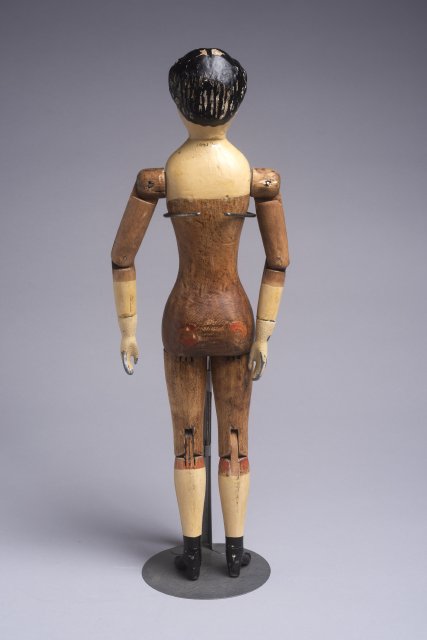
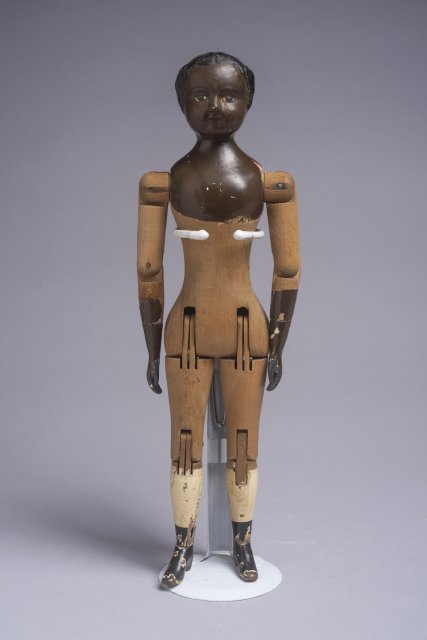
Joel Ellis received about 13 different patents and invented some items that never received patents. One invention in 1848 was a steam excavator for building railroads. The historic museum in Springfield may display his dolls sitting in one of the carriages he invented.
Joel Ellis Dolls and the Springfield Woodens
Other dolls designed by Springfield inventors are easily grouped together with Joel Ellis dolls. One must consider the joints and other features. to tell them apart. If the head turns, it is not an Ellis doll.
Mason & Taylor
In 1881 Henry Hubbard Mason, who came to Springfield in 1844, and Luke Taylor invented a design so that the head of the doll could turn in any direction (US patent 242,210). You can recognize a Mason & Taylor by the blue painted feet, the black band around the waist and, of course, the turning of the head. The leg and arm joints attached by pins or wire appear differently than the Ellis joints. One will notice a more rounded knee joint in the Mason doll as compared to the Ellis doll. Their heads were made of a type of composition. Mason continued manufacturing his dolls until 1893.
Below is an example of the doll designed by Mason and Taylor found at the Bennington Museum in Vermont. Notice the blue metal boots, the band around the waist, the neck joint, and the hip and knee joints that differ from the Joel Ellis doll. (Photos are used with permission.)
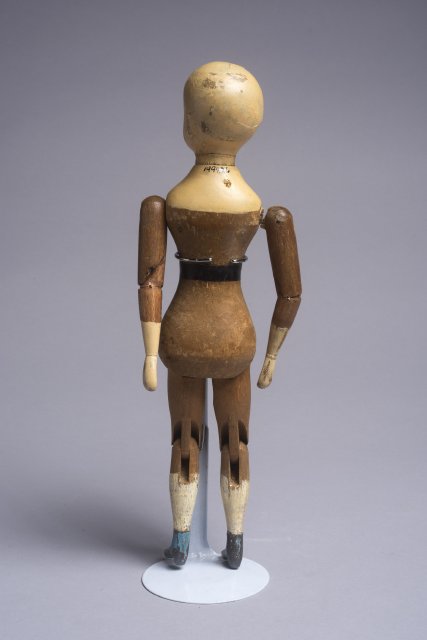
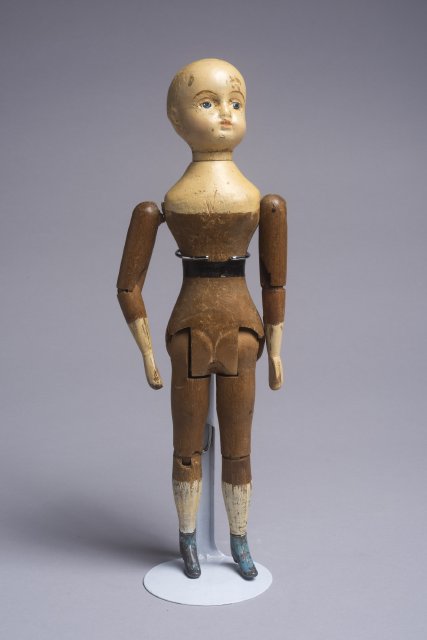
Henry Hubbard Mason
Henry H. Mason had other jobs and business ventures. At one time he worked as proprietor of the Black River Hotel. In partnership with Albert Brown, he manufactured trusses and abdominal supporters as well as the diamond churn or prize churn. Then with David Smith and Hamlin Whitmore he manufactured clothes pins. When he was yet the age of 76, he was selling mop handles, always in some sort of business for himself. He even owned a farmed (once known as the Cook Farm)that lay north of Joel Ellis’ property. His wife was Sarah Cutler
Luke W. Taylor
Taylor, also an inventor, invented the famous “Taylor” mop. He came to Springfield after his wood turning business shop in Upper Falls, VT burned in 1872. Springfield considered Luke W. Taylor has an inventor of rare ability. His reputation was that everything he built was built to perfection.
Charles C. Johnson
Charles C. Johnson improved upon the design of a doll head with a wooden core in 1882 (US patent 267,212). Charles came to Springfield, VT in 1864 after an honorable discharge from the military. In 1868 Springfield elected him as their first constable. He also worked as pension attorney during which he also engaged in patenting several inventions.
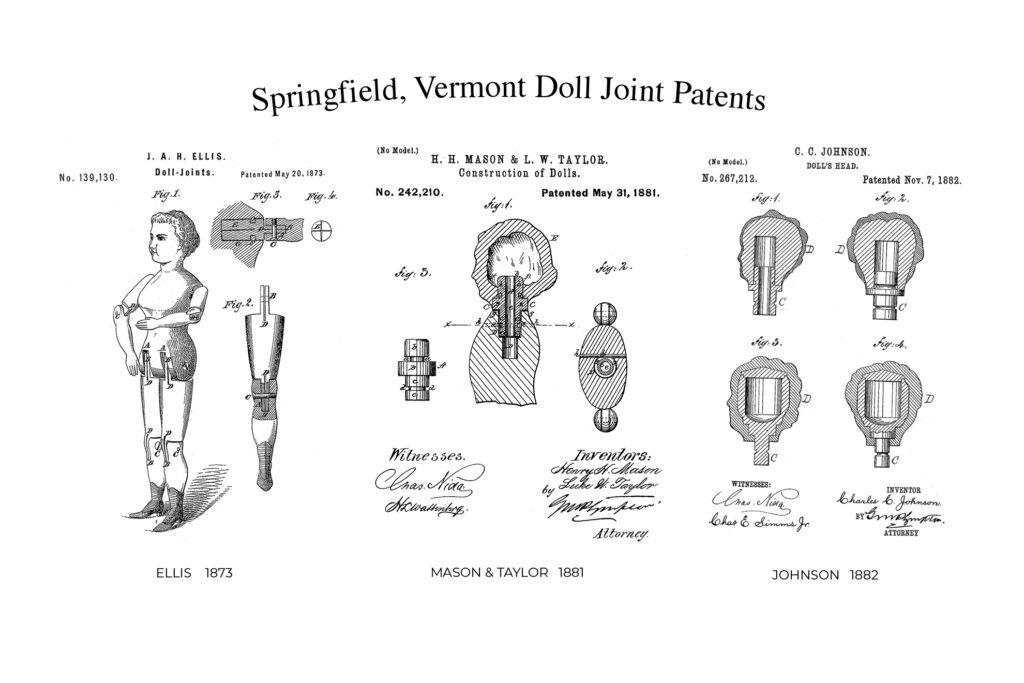
Companies Connected to Joel Ellis Dolls
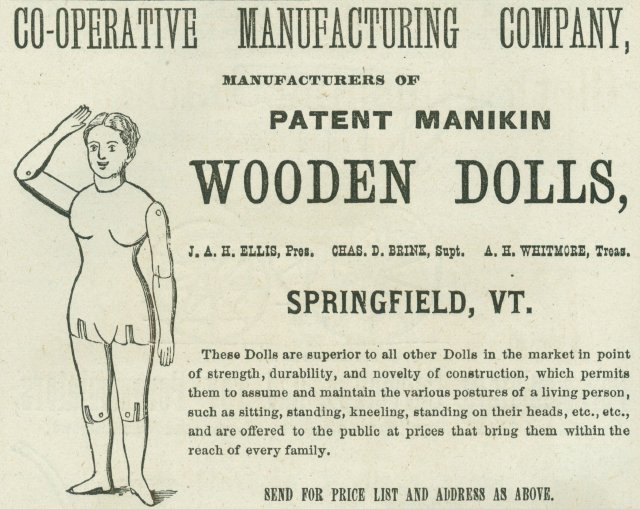
Co-Operative Manufacturing Company
The Co-Operative Manufacturing Company of Springfield organized April 14, 1873 according to the Index to the General and Special Legislation of the State of Vermont. (The Springfield museum claims this company worked on the premises of the Vermont Novelty Works.) The company made wooden head dolls on the property area known as the Upper Dam. According to the History of Windsor County, Vermont the company had a disastrous fire that caused a loss of $30,000.
Walton’s Vermont Register and Farmer’s Almanac of 1875 listed J. A. H. Ellis, President of an Industrial Work Co. selling leather goods and toys.
Jointed Doll Company
Walton’s Vermont Register and Farmer’s Almanac for 1879 , 1880, and 1882 listed the Jointed Doll Company selling jointed doll. They called it the Improved American Wood Jointed Doll and claimed its head could move in any direction.
See a Jointed Doll Company advertisement here.
Read about the all wooden American invented Schoenhut dolls here.
